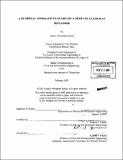A remedial approach to stabilize a deep excavation in Singapore
Author(s)
Ferrari, Alessia Alexandra
DownloadFull printable version (17.32Mb)
Other Contributors
Massachusetts Institute of Technology. Dept. of Civil and Environmental Engineering.
Advisor
Andrew J. Whittle.
Terms of use
Metadata
Show full item recordAbstract
Ground improvement methods are commonly adopted in deep excavation to minimize wall deflection, wall bending moment and strut force. In this thesis a different approach to the application of ground improvement techniques is analyzed in the form of a parametric study developed with the use of a commercial finite element code. A new remedial ground improvement solution applied to an existing deep excavation located in Singapore and part of the Circle Line Project (CCL) for the construction of a new subway line is considered and computationally modeled. The soil profile in the site mainly consists of deep marine soft clay dated for the most part in the Holocene period, principally characterized by a normally to very low overconsolidation ratio, in some location even underconsolidated. The parametric analysis aims to evaluate short-term effects of the application of cementing agents to the lower portion of the marine clay externally to the excavation side. The effectiveness of the proposed ground improvement is examined using a finite element model corresponding to a key cross-section of CCL1 project. (cont.) Parametric analyses are used to assess how the dimensions of the treatment zone and strength of soilcrete columns affect the computed wall deflections, bending moments and strut loads. The results demonstrate the validity of the proposed method in controlling the structural behavior of the excavation support system. The same method is then used to simulate the retrofit of the partially excavated section. The results show it is possible for an external ground treatment to control wall deflections and bending moments and reduce strut loads. The thesis finally discuss the practical advantages of the solution and its limitations.
Description
Thesis (M. Eng.)--Massachusetts Institute of Technology, Dept. of Civil and Environmental Engineering, 2007. Includes bibliographical references (leaves 82-84).
Date issued
2007Department
Massachusetts Institute of Technology. Department of Civil and Environmental EngineeringPublisher
Massachusetts Institute of Technology
Keywords
Civil and Environmental Engineering.